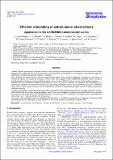Por favor, use este identificador para citar o enlazar a este item:
http://hdl.handle.net/10261/167375COMPARTIR / EXPORTAR:
 SHARE SHARE
 CORE
BASE CORE
BASE
|
|
| Visualizar otros formatos: MARC | Dublin Core | RDF | ORE | MODS | METS | DIDL | DATACITE | |

| Campo DC | Valor | Lengua/Idioma |
|---|---|---|
| dc.contributor.author | García-Piquer, A. | - |
| dc.contributor.author | Morales, Juan Carlos | - |
| dc.contributor.author | Ribas, Ignasi | - |
| dc.contributor.author | Colomé, J. | - |
| dc.contributor.author | Guàrdia, J. | - |
| dc.contributor.author | Perger, M. | - |
| dc.contributor.author | Caballero, J. A. | - |
| dc.contributor.author | Cortés-Contreras, M. | - |
| dc.contributor.author | Jeffers, Sandra V. | - |
| dc.contributor.author | Reiners, Ansgar | - |
| dc.contributor.author | Amado, Pedro J. | - |
| dc.contributor.author | Quirrenbach, Andreas | - |
| dc.contributor.author | Seifert, W. | - |
| dc.date.accessioned | 2018-07-05T07:28:33Z | - |
| dc.date.available | 2018-07-05T07:28:33Z | - |
| dc.date.issued | 2017 | - |
| dc.identifier | doi: 10.1051/0004-6361/201628577 | - |
| dc.identifier | issn: 1432-0746 | - |
| dc.identifier.citation | Astronomy and Astrophysics 604: A87 (2017) | - |
| dc.identifier.uri | http://hdl.handle.net/10261/167375 | - |
| dc.description.abstract | Context. Targeted spectroscopic exoplanet surveys face the challenge of maximizing their planet detection rates by means of careful planning. For a large planet survey, the number of possible observation combinations, i.e., the sequence of observations night after night, both in total time and amount of targets, is enormous. Aims. Sophisticated scheduling tools and the improved understanding of the exoplanet population are employed to investigate an efficient and optimal way to plan the execution of observations. This is applied to the CARMENES instrument, which is an optical and infrared high-resolution spectrograph that has started a survey of about 300 M-dwarf stars in search of terrestrial exoplanets. Methods. We used evolutionary computation techniques to create an automatic scheduler that minimizes the idle periods of the telescope and distributes the observations among all the targets using configurable criteria. We simulated the case of the CARMENES survey with a realistic sample of targets, and we estimated the efficiency of the planning tool both in terms of telescope operations and planet detection. Results. Our scheduling simulations produce plans that use about 99% of the available telescope time (including overheads) and optimally distribute the observations among the different targets. Under such conditions, and using current planet statistics, the optimized plan using this tool should allow the CARMENES survey to discover about 65% of the planets with radial-velocity semi-amplitudes greater than 1 ms when considering only photon noise. Conclusions. The simulations using our scheduling tool show that it is possible to optimize the survey planning by minimizing idle instrument periods and fulfilling the science objectives in an efficient manner to maximize the scientific return.© 2017 ESO. | - |
| dc.description.sponsorship | We acknowledge financial support from the Spanish Ministry of Economy and Competitiveness (MINECO) through grants ESP2013-48391-C4-1-R, ESP2014-57495-C2-2-R, AYA2014-54348-C3-1-R and AYA2014-54348-C3-2-R. A.R. acknowledges support from the European Research Council under the FP7 Starting Grant agreement number 279347 and from DFG grant RE 1664/9-1. | - |
| dc.publisher | EDP Sciences | - |
| dc.relation | info:eu-repo/grantAgreement/EC/FP7/279347 | - |
| dc.relation | info:eu-repo/grantAgreement/MINECO/Plan Estatal de Investigación Científica y Técnica y de Innovación 2013-2016/ESP2013-48391-C4-1-R | - |
| dc.relation | info:eu-repo/grantAgreement/MINECO/Plan Estatal de Investigación Científica y Técnica y de Innovación 2013-2016/ESP2014-57495-C2-2-R | - |
| dc.relation | info:eu-repo/grantAgreement/MINECO/Plan Estatal de Investigación Científica y Técnica y de Innovación 2013-2016/AYA2014-54348-C3-1-R | - |
| dc.relation | info:eu-repo/grantAgreement/MINECO/Plan Estatal de Investigación Científica y Técnica y de Innovación 2013-2016/AYA2014-54348-C3-2-R | - |
| dc.relation.isversionof | Publisher's version | - |
| dc.rights | openAccess | - |
| dc.subject | Stars: late-type | - |
| dc.subject | Planetary systems | - |
| dc.subject | Surveys | - |
| dc.subject | Methods: miscellaneous | - |
| dc.subject | Instrumentation: spectrographs | - |
| dc.title | Efficient scheduling of astronomical observations: Application to the CARMENES radial-velocity survey | - |
| dc.type | artículo | - |
| dc.identifier.doi | 10.1051/0004-6361/201628577 | - |
| dc.date.updated | 2018-07-05T07:28:33Z | - |
| dc.description.version | Peer Reviewed | - |
| dc.language.rfc3066 | eng | - |
| dc.contributor.funder | German Research Foundation | - |
| dc.contributor.funder | Ministerio de Economía y Competitividad (España) | - |
| dc.contributor.funder | European Research Council | - |
| dc.relation.csic | Sí | - |
| dc.identifier.funder | http://dx.doi.org/10.13039/501100001659 | es_ES |
| dc.identifier.funder | http://dx.doi.org/10.13039/501100003329 | es_ES |
| dc.identifier.funder | http://dx.doi.org/10.13039/501100000781 | es_ES |
| dc.type.coar | http://purl.org/coar/resource_type/c_6501 | es_ES |
| item.openairetype | artículo | - |
| item.grantfulltext | open | - |
| item.cerifentitytype | Publications | - |
| item.openairecristype | http://purl.org/coar/resource_type/c_18cf | - |
| item.fulltext | With Fulltext | - |
| Aparece en las colecciones: | (IAA) Artículos | |
Ficheros en este ítem:
| Fichero | Descripción | Tamaño | Formato | |
|---|---|---|---|---|
| IAA_2017_aa28577-16.pdf | 2,5 MB | Adobe PDF |  Visualizar/Abrir |
CORE Recommender
SCOPUSTM
Citations
19
checked on 20-abr-2024
WEB OF SCIENCETM
Citations
20
checked on 28-feb-2024
Page view(s)
248
checked on 23-abr-2024
Download(s)
87
checked on 23-abr-2024
Google ScholarTM
Check
Altmetric
Altmetric
NOTA: Los ítems de Digital.CSIC están protegidos por copyright, con todos los derechos reservados, a menos que se indique lo contrario.
